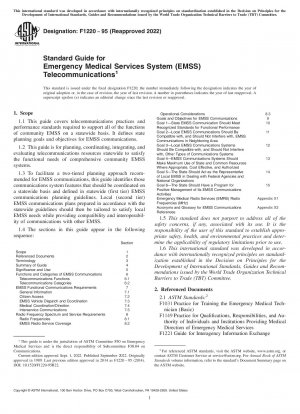ASTM F1220-95(2022)
Standard Guide for Emergency Medical Services System (EMSS) Telecommunications
- Standard No.
- ASTM F1220-95(2022)
- Release Date
- 2022
- Published By
- American Society for Testing and Materials (ASTM)
- Latest
- ASTM F1220-95(2022)
- Scope
- 1.1 This guide covers telecommunications practices and performance standards required to support all of the functions of community EMSS on a statewide basis. It defines state planning goals and objectives for EMSS communications. 1.2 This guide is for planning, coordinating, integrating, and evaluating telecommunications resources statewide to satisfy the functional needs of comprehensive community EMSS systems. 1.3 To facilitate a two-tiered planning approach recommended for EMSS communications, this guide identifies those communications system features that should be coordinated on a statewide basis and defined in statewide (first tier) EMSS communications planning guidelines. Local (second tier) EMSS communications plans prepared in accordance with the statewide guidelines should then be tailored to satisfy local EMSS needs while providing compatibility and interoperability of communications with other EMSS. 1.4 The sections in this guide appear in the following sequence: Section Scope 1 Referenced Documents 2 Terminology 3 Summary of Guide 4 Significance and Use 5 Functions and Categories of EMSS Communications 6 Telecommunications Functions 6.1 Telecommunications Categories 6.2 EMSS Functional Communications Requirements 7 General Information 7.1 Citizen Access 7.2 EMSS Vehicle Dispatch and Coordination 7.3 Medical Coordination/Direction 7.4 Interservice Communications 7.5 Radio Frequency Spectrum and Service Requirements 8 Radio Frequencies 8.1 EMSS Radio Service Coverage 8.2 Operational Considerations 8.3 Goals and Objectives for EMSS Communications 9 Goal 1—State EMSS Communication Should Meet Recognized Standards for Functional Performance 10 Goal 2—Local EMSS Communications Should Be Compatible with, and Should Not Interfere with, EMSS Communications in Neighboring Area 11 Goal 3—Local EMSS Communications Systems Should Be Compatible with, and Should Not Interfere with, Other Types of Communications Systems 12 Goal 4—EMSS Communications Systems Should Make Maximum Use of State and Common Resources Where Appropriate, Cost Effective, and Authorized 13 Goal 5—The State Should Act as the Representative of Local EMSS in Dealing with Federal Agencies and National Organizations 14 Goal 6—The State Should Have a Program for Positive Management of Its EMSS Communications Activities 15 Emergency Medical Radio Services (EMRS) Radio Frequencies (MHz) Appendix X1 Acronyms and Glossary for EMSS Communications Appendix X2 References 1.5 This standard does not purport to address all of the safety concerns, if any, associated with its use. It is the responsibility of the user of this standard to establish appropriate safety, health, and environmental practices and determine the applicability of regulatory limitations prior to use. 1.6 This international standard was developed in accordance with internationally recognized principles on standardization established in the Decision on Principles for the Development of International Standards, Guides and Recommendations issued by the World Trade Organization Technical Barriers to Trade (TBT) Committee.
ASTM F1220-95(2022) Referenced Document
- ASTM F1031 Standard Practice for Training the Emergency Medical Technician (Basic)
- ASTM F1149 Standard Practice for Qualifications, Responsibilities, and Authority of Individuals and Institutions Providing Medical Direction of Emergency Medical Services
- ASTM F1221 Standard Guide for Interagency Information Exchange
- ASTM F1229 Standard Guide for Qualification and Training of EMS Air Medical Patient Care Providers
- ASTM F1254 Standard Practice for Performance of Prehospital Manual Defibrillation (Withdrawn 2007)
- ASTM F1258 Standard Practice for Emergency Medical Dispatch
- ASTM F1287 Standard Guide for Scope of Performance of First Responders Who Provide Emergency Medical Care
- ASTM F1381 Standard Guide for Planning and Developing 9-1-1 Enhanced Telephone Systems
- ASTM F1418 Standard Guide for Training the Emergency Medical Technician (Basic) in Roles and Responsibilities
- ASTM F1453 Standard Guide for Training and Evaluation of First Responders Who Provide Emergency Medical Care
- ASTM F1517 Standard Guide for Scope of Performance of Emergency Medical Services Ambulance Operations
- ASTM F1552 Standard Practice for Training Instructor Qualification and Certification Eligibility of Emergency Medical Dispatchers
- ASTM F1560 Standard Practice for Emergency Medical Dispatch Management
ASTM F1220-95(2022) history
- 2022 ASTM F1220-95(2022) Standard Guide for Emergency Medical Services System (EMSS) Telecommunications
- 1995 ASTM F1220-95(2014) Standard Guide for Emergency Medical Services System 40;EMSS41; Telecommunications
- 1995 ASTM F1220-95(2006) Standard Guide for Emergency Medical Services System (EMSS) Telecommunications
- 1995 ASTM F1220-95(2001) Standard Guide for Emergency Medical Services System (EMSS) Telecommunications
- 2001 ASTM F1220-95 Standard Guide for Emergency Medical Services System (EMSS) Telecommunications
